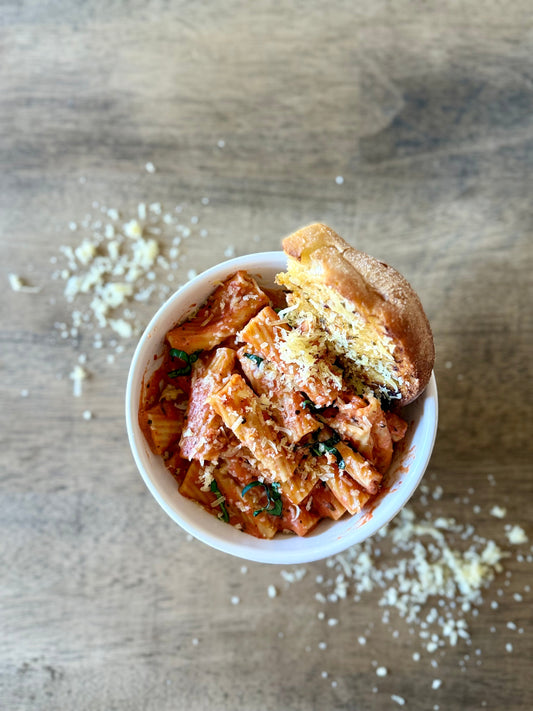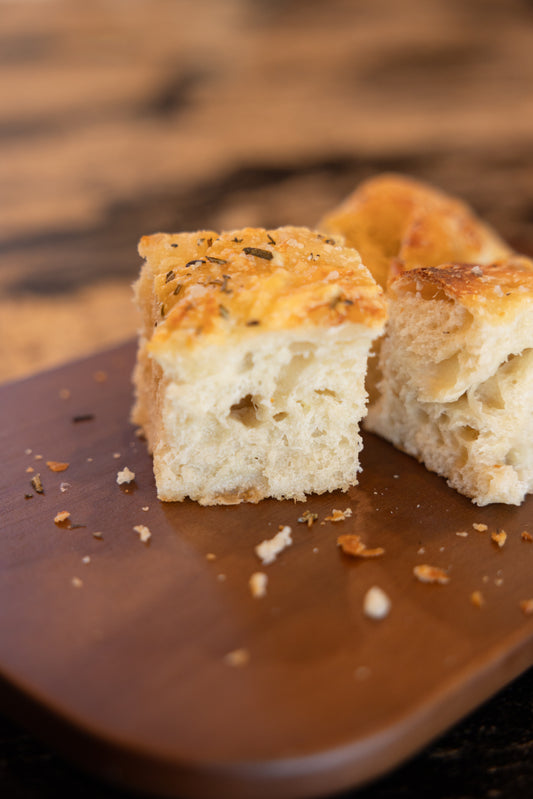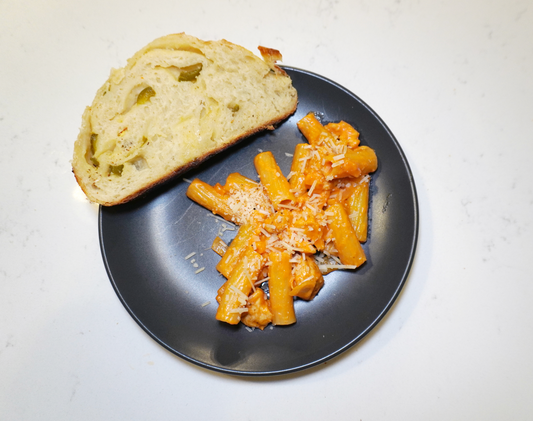Most people know that cheese is made from milk and milk comes from cows, but have you ever wondered how milk gets from the dairy farmer to the cheese maker? Maybe you’ve contemplated the intricacies of this question while stuck behind a slow-moving semi-truck hauling a large, shiny tank down a country road.
While the average milk truck carries a tank that holds between 5,000 and 8,000 gallons of milk and stops at multiple dairies, the tank that we use at Rockhill Creamery holds a maximum of 215 gallons and travels to just one single dairy on the back of a flatbed pickup. Still, much of the process involved in transporting milk remains the same regardless of scale. Our micro milk tank is made from stainless steel that’s easy to keep shiny clean, and it’s heavily insulated to keep the milk cool. Each time it’s used, we start by sanitizing the tank, and closing it up tight before driving to the dairy.
Rockhill's micro milk tank strapped to the flatbed and ready for the road.

In the winter, driving to and from the dairy to pick up milk is my least favorite part of the job. We get our milk from Cache Meadow Creamery, which is only 10 miles away, but half of the drive is on country roads that are a last priority for the snow plows. On snowy days when a faint shadow of tire tracks in a sea of white is the only indication of where the road is, I’m thankful that I spend most of my time making cheese rather than driving a milk truck. (I only haul milk about once a month, while my business partner Pete does the rest.) But arriving at the dairy always cheers me up.
Cache Meadow is a small, grazing-based family dairy. They milk mostly Jersey cows (along with a Brown Swiss or two that came from Rockhill when we quit milking), and when I pull up in the milk truck on winter mornings, the cows are all lined up in the corral enjoying hay for breakfast after having finished their milking duty. In summer, they quickly head out to pasture to eat fresh grass for breakfast. Watching cows eat is my favorite part of the job – except that it's not really supposed to be a part of my job, so I try not to get too distracted and move quickly to get the milk hose connected and ready to pump milk into our tank.
Cows eating breakfast on a late fall day at Cache Meadow Creamery.

Mark and Andrea Kezerian are the owner/operators of Cache Meadow Creamery. Mark milks the cows on the mornings that we pick up milk, while Andrea feeds calves and keeps an eye on their four kids. On the days that we don’t buy milk, they process it – bottling, separating, fermenting, and churning to put raw milk, cream, yogurt, and ice cream on the shelf in their on-farm store. Selling to Rockhill has given them an additional outlet for their milk, relieving a small portion of the processing and marketing challenges.
Mark finishes milking the cows about the time I pull up in the milk truck. While I connect a hose from the tank on our truck to a small pump inside the milk room, Mark connects his bulk tank to the same pump. He measures the amount of milk in his tank, and I record the measurement along with the temperature of the milk, which has already cooled to below 45F. Then, with the flip of a switch, somewhere between 900 and 1000 lbs of milk gets pumped from his tank into ours. A few minutes later, we disconnect all the hoses, and I begin the short drive back to Rockhill.
The process of unloading the milk into the cheese vat in our creamery is much the same, except no pump is involved. As evident from our name, the historic farm that houses Rockhill Creamery is located on a hill. I park the truck uphill from the creamery, connect one end of a hose to the tank and insert the other end through a port in the creamery window. Someone else working inside the creamery connects another hose that extends to the cheese vat. Once all the connections are made, I open the valve on the milk tank, and gravity does the rest. Given that one year ago when we milked our own cows I regularly hauled 1000 lbs of milk from the milk parlor to the creamery by hand in 5-gallon buckets, the ease of a gravity-powered system still seems miraculous. (The tradeoff is that now I have a gym membership.)
Unloading milk: the view from inside the creamery waiting for the milk truck to arrive.

Once all the milk has flowed out of the tank and all the hoses have been disconnected, I begin what for me is the most challenging part of milk hauling – manipulating Pete’s old flatbed Ford with the turning radius of a school bus and the milk tank blocking the rearview around two sharp corners to get it backed perfectly into position to unload the milk tank. All this manipulating is necessary because of the ingenious way Pete devised to convert our old milk parlor into a cleaning bay after we decided to stop milking cows and start buying milk last summer.
In order to buy milk we needed an approved milk transport tank and a place to wash the milk tank after each use. The building that used to be our milk parlor had all the requisite plumbing and protection from the elements to serve as a cleaning bay for the milk tank. The problem was how to get the milk tank into the small room for cleaning and storage. And how to make it possible on a tight schedule so that we could move the cows out after a Monday cheese make and have everything in place to haul milk for the following Thursday cheese make.
Milk parlor before and after


Pete’s plan was to use a motorcycle lift table, which he mounted on large wheels so that we could easily push it in and out through the same door the cows had used to come in off of the corral. The lift table has a foot-operated pump that raises it up to the same level as the bed of the pickup. Pete also added rollers to the milk tank and tracks to the bed of the truck and the top of the lift table. The idea was that we would roll the milk tank off the bed of the truck, onto the lift table, then lower the lift table and push the whole thing into the cleaning bay. Given that the milk tank weighs 474 lbs empty, I had my doubts about this plan, but through the same careful engineering and thrifty ingenuity that he used to restore his historic farm and transform it into an artisan cheese making business, Pete made it work.
Unloading the milk tank from the truck in preparation for cleaning.

Now, once I’ve backed the truck into place, it is indeed easy for me to push the empty milk tank off of the truck bed onto the lift table and move the whole thing into the cleaning bay. The cleaning process is also relatively quick and easy, as the clean-in-place system uses a pump to spray the inside of the tank clean. Once the tank is clean, I turn off the lights and head over to the creamery to spend the rest of my day turning the milk into cheese.





